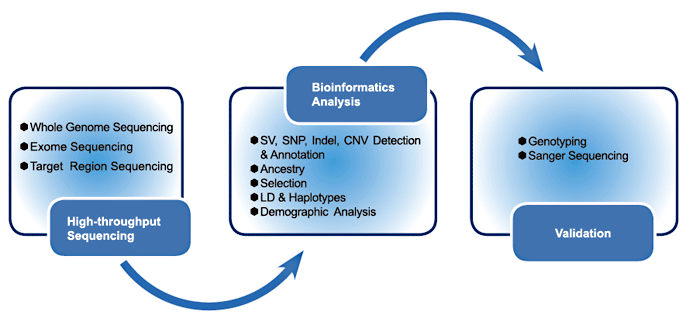
Population Genetics
Population genetics is the study of a population’s genetic constitution (allele frequency distribution) and how it changes over time as a result of the evolutionary processes such as mutation, natural selection, genetic drift, etc. These studies are aimed at the detection of genomic variations and evolutionary processes that can influence the frequency of these variations which can shed light on the evolutionary history and structure of populations. BGI possesses the advanced DNA analysis and bioinformatics capabilities necessary to help our clients reach a successful outcome for such a studies. BGI is also at forefront of this realm of study and has established that low-coverage sequencing is a powerful method for population analysis. Below are some Population Genetics studies in which BGI played a role as either a collaborator or service provider.
Example : The Netherlands Genome Project
 The Project will establish a map of genetic variants in 750 samples from Dutch biobanks and build the reference database for future disease oriented genomics research. BGI is responsible for sequencing 750 genomes representing 250 trios (the genomes of two parents and one offspring) which will help to determine how a certain variant fits within the paternal and maternal patterns. This project is expected to reveal most of the genetic variation within the Dutch population and among different regions. It is expected that this study will reveal many low-frequency variants that were unobserved in the European 1000 Genomes data.
The Project will establish a map of genetic variants in 750 samples from Dutch biobanks and build the reference database for future disease oriented genomics research. BGI is responsible for sequencing 750 genomes representing 250 trios (the genomes of two parents and one offspring) which will help to determine how a certain variant fits within the paternal and maternal patterns. This project is expected to reveal most of the genetic variation within the Dutch population and among different regions. It is expected that this study will reveal many low-frequency variants that were unobserved in the European 1000 Genomes data.
Example: Adaptation to High Altitude
 As part of a study published in Science in 2010, the exomes of 50 ethnic Tibetans were sequenced at a depth of 18X each. Genes showing population-specific allele frequency changes, which represent strong candidates for altitude adaptation, were identified. One SNP at EPAS1 showed a 78% frequency difference between Tibetan and Han samples, representing the fastest allele frequency change observed at any human gene to date. This project can help researchers in their efforts to prevent and cure the disease of plateau-anoxia.
As part of a study published in Science in 2010, the exomes of 50 ethnic Tibetans were sequenced at a depth of 18X each. Genes showing population-specific allele frequency changes, which represent strong candidates for altitude adaptation, were identified. One SNP at EPAS1 showed a 78% frequency difference between Tibetan and Han samples, representing the fastest allele frequency change observed at any human gene to date. This project can help researchers in their efforts to prevent and cure the disease of plateau-anoxia.
Example : Evolution and Migration
 In 2010, researchers obtained DNA from a 4,000-year-old permafrost-preserved human hair. Genomic DNA was isolated and sequenced revealing that it was a male individual who was a member of the first known population to settle in Greenland. SNP analysis of the sequence data enabled the researchers to assign possible phenotypic characteristics of this individual and identify the population to which he is most closely related. This analysis provided evidence that there was human migration from Siberia into the New World about 5,500 years ago, and this migration was independent of the one that gave rise to the modern Native Americans and Inuits.
In 2010, researchers obtained DNA from a 4,000-year-old permafrost-preserved human hair. Genomic DNA was isolated and sequenced revealing that it was a male individual who was a member of the first known population to settle in Greenland. SNP analysis of the sequence data enabled the researchers to assign possible phenotypic characteristics of this individual and identify the population to which he is most closely related. This analysis provided evidence that there was human migration from Siberia into the New World about 5,500 years ago, and this migration was independent of the one that gave rise to the modern Native Americans and Inuits.

Fig.1 Strategies for high-through sequencing in human population genetics research

